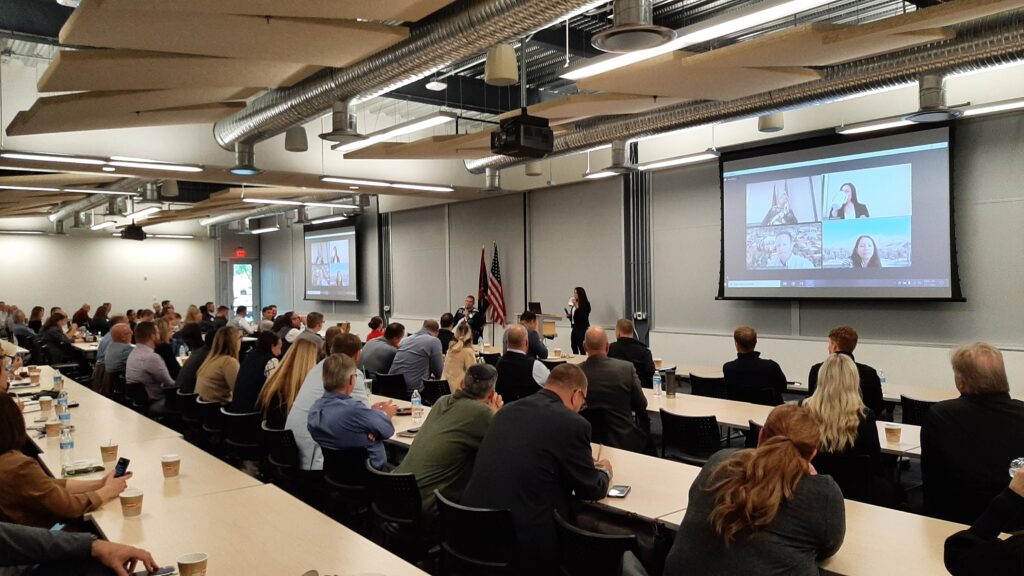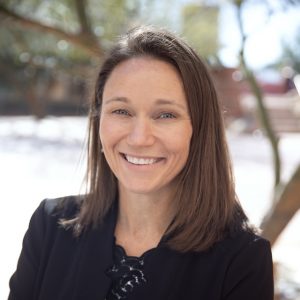The last BEX Companies Leading Market Series event of 2022 – Higher Education – was also one of its best attended as a sold out crowd filled ASU’s SkySong Building 3 Synergy II meeting space Tuesday morning.
After a brief welcome from BEX President and Founder Rebekah Morris, moderator Cassie Robertson, Southwest regional prefab leader for DPR Construction introduced the panel.
Appearing in person for Arizona State University was Alexander Kohnen, VP of facilities development and management. Attending virtually were Peter Dourlein, associate VP of planning, design & construction for the University of Arizona and Stephanie Bauer, assistant director of facility services for planning, design and construction at Northern Arizona University.

Arizona State University
Kicking off the panelist presentations, Kohnen said ASU has six projects headed to the Joint Committee on Capital Review for the Arizona Joint Legislative Budget Committee in the immediate future. He stressed a great deal of ASU’s upcoming work focuses on projects dedicated to lab space to accommodate the university’s exploding student growth and demand in research-focused fields. ASU currently has more than $700M in funded research, he said, and needs space to deal with the volume.
A Job Order Contract request focused on laboratory work is expected to come out in the spring, he said, advising attendees to be on the lookout.
He also explained that the university’s student growth has contributed to already high demand for housing. Since ASU has a policy requiring all first year in-person students to live on campus, large volumes of students have been temporarily housed in area hotels for extended periods while they wait for space. Adding to the need is the fact that much of the university’s housing stock is out of date and in need of renovation to make it current and appealing.
Lastly, Kohnen turned his attention to the ASU Polytechnic Campus in Mesa. The first building in the ASU School of Manufacturing Systems & Networks, Polytechnic Campus plan is currently in design, and the second, he said, is coming soon.
University of Arizona
Dourlein said the current year has been one of reemergence from the pandemic and focusing on growth. The current student body is approximately 52,000, while the research portfolio exceeds $800M and is projected to hit $1B.
Much of Dourlein’s presentation covered the UA Capital Improvement Plan and Annual Capital Plan. Given that UA has a large number of old buildings that need upgrades, renovation and revitalization projects are front of mind for the university at the moment. Many projects in that space will be managed as JOCs.
For larger projects, he said UA is leaning heavily on Design-Build delivery methods, although there may be Construction Manager At Risk projects as the need arises. “We’re having great success with Design-Build right now, so we’re continuing down that road,” he said.
He then launched into a rapid-fire recap of projects included in the Annual Capital Plan that have not yet been awarded. These projects include:
- A remodel of the Shantz Building, currently reviewing the submission,
- Mining Mineral & Natural Resources Education Museum Renovation, expected to be announced in Q1,
- Arizona State Museum Renovation RFQ is expected in Q1.
Another project on the list and currently out for procurement is the College of Agriculture and Life Sciences Food Products and Safety Lab Renovation and Animal Feeding and Resource Capture Facility.
The first year of UA’s recent Capital Improvement Plan has no new projects, as most of the work was covered in the Annual Capital Plan. Dourlein again recapped several projects, noting that projects become moved from the wish list into reality when they receive funding.
Projects included in his CIP recap included an overview of the UA Center for Advanced Molecular and Immunological Therapies. CAMI has two buildings, one of which may be undertaken as a public-private partnership while the other, larger building will be a more traditional Design-Build delivery. CAMI will complete UA’s “superblock” in downtown Phoenix. The RFQ is expected in Q1.
UA’s housing needs have generated two projects expected to release for consideration in the near future, one of approximately 1,000 beds and another of 800.
The remainder of the projects and focuses Dourlein mentioned dealt with campus infrastructure, including:
- Deescalating the use of historic Centennial Hall and creating a new 2,500 performing arts venue,
- A new art museum, and
- A new student engineering design center.
Northern Arizona University
When her turn came around, NAU’s Bauer told the audience the university is currently working on its first Campus Master Plan in 12 years. As a result, major capital project identification and planning are on hold until the master plan is complete.
Future development focus will center not so much on adding new space, but rather in optimizing existing space and reconfiguring uses. The draft plan is expected for release in summer 2023.
In the interim, the focus will fall on deferred maintenance, facility improvements and renovations. Most of those projects will be procured as JOCs.
Q&A
With time running short, Robertson pitched a series of quick questions to the panelists. The first question concerned what has worked and not worked in the universities’ project development and procurement efforts.
Bauer said NAU needs contractors and design firms to be innovative and patient and to help guide the university around some of its historically self-imposed roadblocks. Dourlein agreed, saying innovation and adaptability are vital in managing UA’s projects. At ASU, Kohnen said the need is for better time management and understanding from providers that budgets are locked in place. He said providers need to explain how they will secure partners to complete projects.
When Robertson turned to the audience for questions, the one that grabbed everyone’s attention was a request to explain how sustainability goals are impacting construction budget constraints.
Kohnen said sustainability adds to costs, but that students demand it and it is part of the ASU brand. He added that there is, by necessity, a tradeoff between sustainability focus and program scope. “We’re going to have to start looking at the program and say, ‘Do we sacrifice sustainability or do we sacrifice program?’ We need direction from the leadership on which way that’s going to go. It used to always be program was sacrosanct. I think that’s going to shift this year.”
Bauer said NAU has struggled with maintenance and is looking at how to manage the demand for improved sustainability while keeping projects on pace. She added that it is causing planners to focus more clearly on their future projects and new construction direction to achieve sustainability goals. “We have a lot of different ideas from our Climate Action Plan that we need to choose a direction on how we’re going to go. That will inform how, when we do go forward with new construction, what components will be in those buildings in the future.”
Dourlein said UA is working on a comprehensive sustainability and climate action plan, which is focusing on decarbonization of the campus.
“Some of the trends that I’ve noticed is the long-term cost of maintaining a building or heating and cooling it isn’t being benefitted all that much from getting the LEED certification. We’re already doing all that to a high degree. The LEED certification keeps escalating, and it’s adding cost that we’re not necessarily seeing benefit from. It’s probably sacrilegious to say, ‘One day we won’t build to LEED standards…,” but I think that’s part of the ongoing discussion and uncertainty.
“We do need our buildings to be maintainable and cost-efficient over the long haul… I think there are some things that are evolving there that I don’t have an answer to that I think are going to impact sustainability and design and construction. It’s going to have to be a little more of a value proposition.”

 STEVE BOSCHEN
STEVE BOSCHEN WENDY COHEN
WENDY COHEN ERIC FROBERG
ERIC FROBERG



 REBEKAH MORRIS
REBEKAH MORRIS